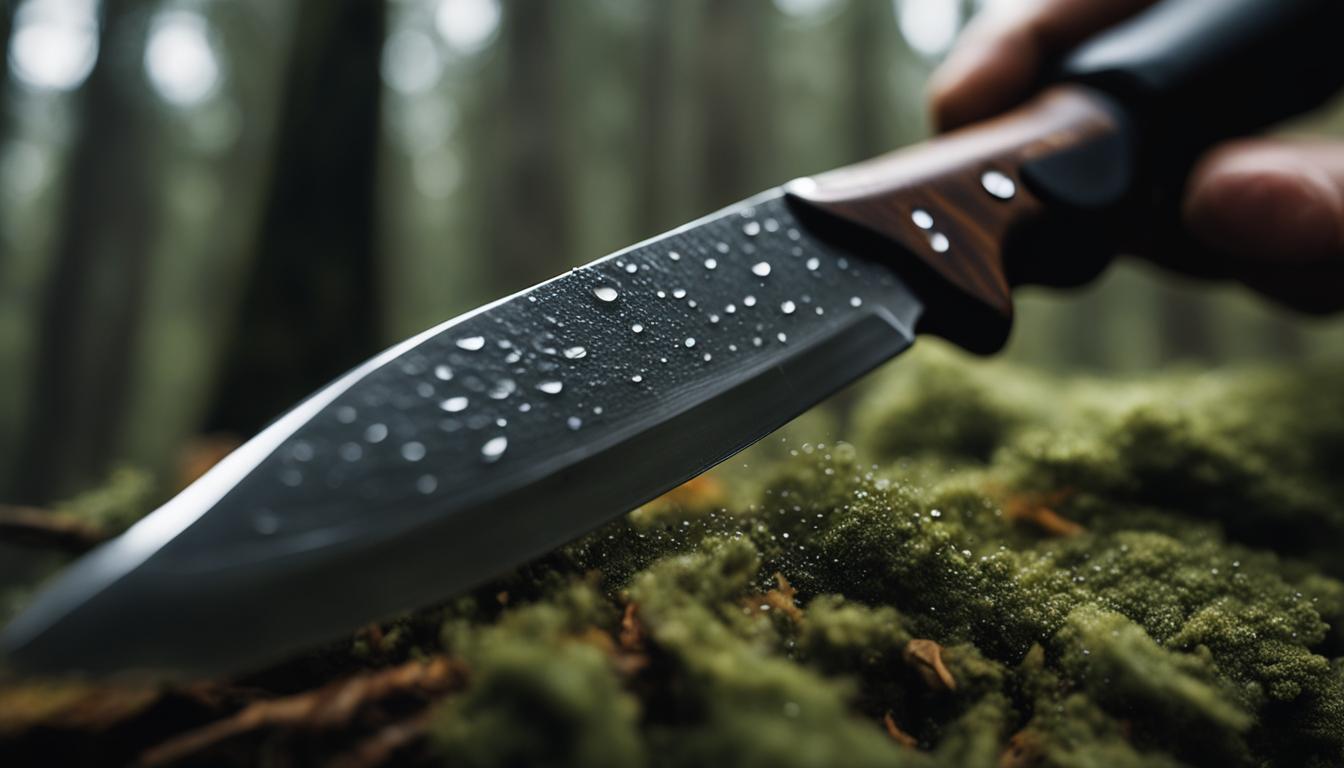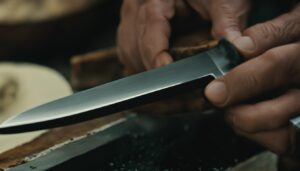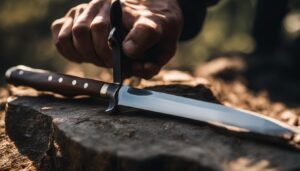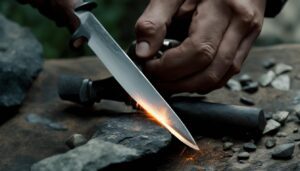As a beginner in knife care, it’s crucial to understand the essential maintenance tips to keep your hunting knives in pristine condition. Proper care not only ensures their longevity but also enhances their performance. Whether you’re a seasoned hunter or just starting out, these beginner knife maintenance tips will help you maintain your knives effectively.
Key Takeaways:
- Regular knife maintenance is essential for preserving their sharpness and preventing rust.
- Clean and dry your knives after each use to prevent corrosion.
- Store your knives in a cool, dry place to avoid moisture damage.
- Sharpen your knives regularly using appropriate methods for optimal performance.
- Different knife types require specific care techniques to maintain their quality.
Proper Cleaning and Storage Techniques
Maintaining the cleanliness and proper storage of your hunting knives is vital for their longevity and performance. By following these essential knife upkeep basics, you can ensure that your knives remain in optimal condition for years to come.
The Cleaning Process
After every use, it’s essential to clean your hunting knives thoroughly. Start by wiping off any debris or residues with a soft cloth or paper towel. Be cautious not to use abrasive materials that could damage the blade’s integrity.
Next, use warm soapy water to wash the blade and handle, ensuring that all areas are cleaned. Pay extra attention to any spots that may have accumulated dirt or moisture. Rinse the knife with clean water and pat it dry with a cloth.
Remember to avoid soaking your knives or putting them in the dishwasher, as excessive moisture can lead to rust or damage the handle’s materials. Additionally, it’s crucial to avoid using harsh chemicals or abrasive cleaning agents that can corrode the blade.
Proper Storage Techniques
Once your hunting knives are clean and dry, it’s time to store them correctly. The key to proper storage is protecting the blades from moisture and contact with other objects that could damage them.
Consider investing in a knife sheath or blade guard to protect the blade and prevent accidental cuts. These protective coverings also help to keep your knives secure while in storage or during transportation.
For long-term storage, it’s advisable to apply a light coat of oil to the blade to prevent corrosion. Use a rust-preventive oil or a food-grade mineral oil, applying it thinly and evenly across the entire blade surface. Make sure to wipe off any excess oil to avoid a greasy residue.
| Knife Cleaning and Storage Tips |
|---|
| Always clean your knives after use and before storage. |
| Avoid soaking your knives or using harsh cleaning chemicals. |
| Invest in a knife sheath or blade guard for storage and transportation. |
| Apply a thin coat of rust-preventive oil for long-term storage. |
By following these knife upkeep basics for cleaning and storage, you’ll ensure that your hunting knives stay in optimal condition, ready for your next outdoor adventure.
Sharpening Methods for Beginners
Sharpening your knives is an essential part of knife maintenance. Properly sharpened knives not only enhance their cutting performance but also ensure safer usage. If you’re new to sharpening knives, here are some beginner-friendly methods you can try:
1. Whetstone Sharpening
Whetstone sharpening is a traditional and effective method for sharpening knives. Start by soaking the whetstone in water for a few minutes. Place the stone on a stable surface and hold the knife at a 20-degree angle. With consistent pressure, glide the blade across the stone in a sweeping motion, alternating sides until the blade is sharpened. Remember to maintain a steady angle and use water or honing oil to keep the stone lubricated.
2. Honing Rod
A honing rod, also known as a sharpening steel, is a tool used for realigning the knife’s edge between sharpenings. Hold the rod upright in your non-dominant hand and grip the knife handle in your dominant hand. Position the heel of the blade against the top of the rod, then draw the knife down and towards you, maintaining a consistent angle. Repeat this motion on both sides of the blade, alternating until the desired sharpness is achieved.
3. Knife Sharpeners
If you prefer a more user-friendly approach, electric or manual knife sharpeners can be a convenient option. These devices have pre-set angles and abrasive materials that help sharpen the blade quickly. Follow the manufacturer’s instructions for the specific sharpener you’re using and ensure that you don’t over-sharpen the knife, as it can lead to unnecessary wear on the blade.
4. Professional Sharpening Services
If you’re unsure about sharpening your knives yourself, you can always seek professional sharpening services. These professionals have the necessary expertise and equipment to restore your knives’ sharpness effectively. Research local knife sharpening services or inquire at your nearest kitchenware store for recommendations.
Remember, practice makes perfect when it comes to sharpening knives. Don’t be discouraged if you don’t achieve razor-sharp results right away. By mastering these sharpening methods, you’ll be able to maintain the essential sharpness of your knives and ensure their longevity.
| Method | Description |
|---|---|
| Whetstone Sharpening | A traditional and effective method, involving the use of a whetstone to sharpen the knife blade at a specific angle. |
| Honing Rod | A tool used for realigning the knife’s edge between sharpenings, helping to maintain its sharpness. |
| Knife Sharpeners | Electric or manual devices designed to quickly sharpen the knife blade with pre-set angles and abrasive materials. |
| Professional Sharpening Services | Seeking the help of professionals who have the expertise and equipment to accurately sharpen your knives. |
Maintaining Different Knife Types
When it comes to knife maintenance, it’s essential to understand that different types of knives require specific care. Whether you own a pocket knife, a chef’s knife, or a hunting knife, here are some tips to help you keep them in optimal condition:
Pocket Knives
Pocket knives are versatile tools that require regular cleaning and lubrication. To maintain your pocket knife:
- Wipe down the blade with a clean cloth after each use to remove any debris or moisture.
- Apply a small amount of oil to the pivot point to ensure smooth opening and closing.
- Keep the knife in a dry place, away from moisture and humidity.
Chef’s Knives
Chef’s knives are essential in the kitchen and need proper care to stay sharp and reliable. Here’s how to maintain your chef’s knife:
- Hand wash the knife with warm, soapy water after each use.
- Dry the blade immediately to prevent any moisture from causing rust.
- Sharpen the knife regularly using a honing rod or a sharpening stone.
Hunting Knives
Hunting knives endure tough conditions and must be properly maintained to ensure their longevity. Follow these steps to care for your hunting knife:
- Clean the blade thoroughly after each use, especially if it has come into contact with blood or meat.
- Apply a light coat of oil to prevent rust and corrosion.
- Store the knife in a sheath or a dry place to protect it from external elements.
Table: Maintenance Tips for Different Knife Types
| Knife Type | Cleaning | Sharpening | Storage |
|---|---|---|---|
| Pocket Knives | Wipe clean after each use | Regular lubrication | Dry place, away from moisture |
| Chef’s Knives | Hand wash and dry immediately | Regular honing or sharpening | Proper knife block or sheath |
| Hunting Knives | Thorough cleaning after use | Light oil application | Protective sheath or dry storage |
(img src=”https://seowriting.ai/32_6.png” alt=”Knife types”)
By following these maintenance tips for different knife types, you’ll be able to maximize the performance and lifespan of your knives. Remember, each knife requires specific care, so make sure to give them the attention they deserve. With proper maintenance, your knives will remain sharp, reliable, and ready for any task at hand.
Frequency of Sharpening
Properly maintaining the sharpness of your hunting knives is crucial for optimal performance. The frequency of sharpening your knives depends on various factors, including how often you use them, the type of tasks performed, and the quality of the blade. Here are some guidelines to help you determine when it’s time to sharpen your knives:
Usage Frequency
Regularly inspect the cutting edge of your knife to assess its sharpness. If you notice that it’s becoming dull or struggling to slice through materials smoothly, it’s a clear indication that it needs sharpening. Knives used for heavier tasks, such as field dressing and skinning, may require more frequent sharpening compared to those used for lighter tasks like food preparation.
Quality of Cuts
Pay attention to the quality of the cuts you’re achieving with your knife. If you notice that it’s requiring more force or causing tearing instead of clean cuts, it’s a sign that the blade has dulled. Sharpening it will ensure that you achieve precise and efficient cuts, reducing the risk of accidents and making your knife more effective.
Visual Inspection
Regularly inspect your knife’s blade under proper lighting conditions to look for any nicks, chips, or uneven edges. These imperfections can affect the performance of your knife and may indicate the need for sharpening. If you notice any visible damage or inconsistencies, it’s time to sharpen your knife to restore its cutting edge.
Personal Preference
Ultimately, the frequency of sharpening your hunting knives may also depend on your personal preference and the level of performance you desire. Some individuals prefer to maintain their knives in peak condition and sharpen them regularly, even if they haven’t completely dulled. Others may opt to wait until the knives are noticeably dull. Experiment with different sharpening schedules to find what works best for you and your specific needs.
By following these guidelines, you’ll be able to keep your hunting knives sharp and ready for any task at hand. Regular sharpening ensures that your knives are always in peak condition, providing you with optimal performance and longevity.
| Factors to Consider | Sharpening Frequency |
|---|---|
| Usage Frequency | Regularly inspect and sharpen as needed |
| Quality of Cuts | Sharpen when cuts become less precise and require more force |
| Visual Inspection | Sharpen if you notice nicks, chips, or uneven edges |
| Personal Preference | Experiment with different sharpening schedules based on desired performance |
Conclusion
Proper knife maintenance is essential for beginners to ensure the longevity and sharpness of their hunting knives. By following these knife care basics, you can keep your blades in top-notch condition for years to come.
Remember to regularly clean and store your knives after each use. This helps prevent rust and keeps the blades in optimum condition. Additionally, sharpening your knives regularly will ensure they remain sharp and ready for use when you need them.
It’s important to note that different knife types require specific care. Whether you own a folding knife, a fixed blade knife, or a serrated knife, make sure to follow the appropriate maintenance techniques to keep them in pristine condition.
Finally, the frequency of sharpening your knives depends on how often you use them. As a general rule of thumb, check the sharpness of your blades regularly and sharpen them as needed to maintain their cutting effectiveness.
FAQ
How often should I clean and store my hunting knives?
It is crucial to clean and store your hunting knives after each use. This will help prevent rust and maintain their sharpness.
What are some proper cleaning and storage techniques?
After using your hunting knife, wash it with mild soap and warm water. Dry it thoroughly before storing it in a clean, dry place. Avoid storing your knife in a sheath or leather pouch, as these can trap moisture and lead to rust.
How do I sharpen my hunting knives?
There are several methods you can use to sharpen your knives. One common method is to use a sharpening stone. Hold the knife at a consistent angle and run it along the stone in a smooth motion. Another option is to use a sharpening steel, which is ideal for quick touch-ups. Simply hold the steel at a slight angle and slide the blade along its surface.
How can I maintain different types of knives?
Different types of knives require specific care. For stainless steel knives, clean them with mild soap and warm water, and dry them thoroughly after each use. Carbon steel knives, on the other hand, need to be dried immediately after cleaning to prevent rust. Additionally, knives with wooden handles should be hand-washed and periodically treated with oil to keep the wood in good condition.
How often should I sharpen my hunting knives?
The frequency of sharpening your knives depends on their usage. As a general guideline, you should sharpen your hunting knives after every few uses or whenever you notice a decrease in their cutting performance. Regular maintenance will help keep them sharp and ready for use.
Why is proper knife maintenance important?
Proper knife maintenance is essential for preserving the longevity and sharpness of your knives. Regular cleaning, storage, and sharpening will prevent rust, maintain cutting performance, and prolong the lifespan of your hunting knives.





